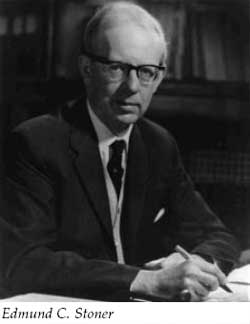Edmund C. Stoner and the Discovery of the Maximum Mass of White Dwarfs

By Michael Nauenberg, University of California, Santa Cruz
The existence of a mass limit for white dwarfs is usually attributed solely to Subramanyan Chandrasekhar, and this limit is now named after him. But as is often the case, the history of this discovery is more nuanced. Actually, the existence of a maximum mass was first established by Edmund C. Stoner, who a few years earlier had played an important role in Pauli’s formulation of the exclusion principle in quantum physics. Stoner’s interest in dense stars was aroused by Ralph Fowler’s application of this principle to solve the puzzle of the origin of the extremely high density of white dwarfs, which could not be explained by classical physics. Stoner subsequently applied the minimum-energy principle to obtain the equilibrium properties of dense stars in a constantdensity approximation, substituting for the internal energy Fowler’s non-relativistic equation of state for a degenerate electron gas. In particular, he found that the density increases with the square of the mass of the star. But alerted by Wilhem Anderson that for white dwarfs with masses comparable to the Sun’s this result implied that the electrons become relativistic, Stoner obtained the fully relativistic equation of state for a degenerate electron gas.Based on solid theoretical foundations, Stoner then calculated the properties of white dwarfs for arbitrary densities, and obtained the critical mass in the limit that the density approaches infinity. His paper, “The Equilibrium of White Dwarfs,” appeared in 1930—a year before publication of Chandrasekhar’s first short paper on his calculation of the critical mass. Chandrasekhar acknowledged that his result was in “agreement” with Stoner’s, but he also claimed, without giving a valid proof, that the critical mass was a maximum. But this result had already been demonstrated by Stoner, who had shown that the mass is a monotonically increasing function of the density, while it took Chandrasekhar several additional months before he found a valid argument for this conclusion and he was able to show that the density becomes infinite to Stoner, he claimed that “they had never examined the ramifications” of the relativistic equation of state. With regard to Stoner, however, this claim is incorrect. In his 1983 Nobel prize lecture, Chandrasekhar gave a historical review of his work on white dwarfs but did not cite Stoner’s prior work. This universal neglect of Stoner’s seminal work on white dwarfs explains why, with a few notable exceptions, his contributions to the discovery of the maximum mass of white dwarfs have been forgotten until now. n Editor’s Note: Nauenberg’s complete article on Stoner will appear in the May issue of the Journal of the History of Astronomy. at the critical mass. At about the same time, Lev Landau, who was a visitor in Zurich collaborating with Pauli’s assistant, Rudolf Peierls, also evaluated the critical mass.
Stoner was encouraged by Arthur S. Eddington to pursue further the implication of his relativistic equation of state for stellar structure, and he communicated Stoner ’s last two papers on this subject to the Monthly Notices of the Royal Astronomical Society. His correspondence with Stoner deepens the mystery why several years later, in a devastating public attack on Chandrasekhar ’s similar work on white dwarfs, Eddington rejected Stoner’s relativistic equation of state, and its profound implication for the existence of a white dwarf mass limit. Eddington’s criticisms were entirely unfounded, but his enormous prestige led to the acceptance of his views by a majority of the astronomical community, and to the initial rejection of Chandrasekhar’s work.
In Kameshwar Wali’s excellent biography of Chandrasekhar, Stoner is never mentioned. More recently, in his book The Empire of Stars, Arthur Miller remarked, “It was indeed extraordinary that a nineteen-year-old Indian youth had managed to make a discovery that had eluded the great minds of European astrophysics.” Although Miller refers briefly to Anderson and to Stoner, he claimed that “they had never examined the ramifications” of the relativistic equation of state. With regard to Stoner, however, this claim is incorrect. In his 1983 Nobel prize lecture, Chandrasekhar gave a historical review of his work on white dwarfs but did not cite Stoner’s prior work.
This universal neglect of Stoner’s seminal work on white dwarfs explains why, with a few notable exceptions, his contributions to the discovery of the maximum mass of white dwarfs have been forgotten until now.
Editor’s Note: Nauenberg’s complete article on Stoner will appear in the May issue of the Journal of the History of Astronomy.
